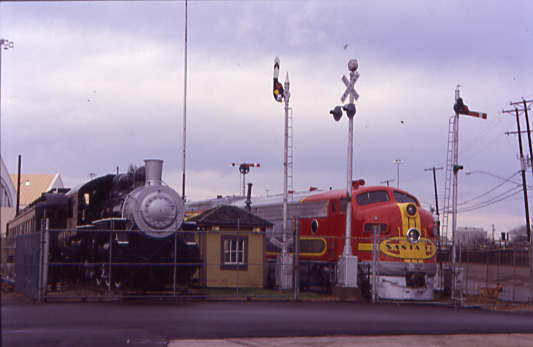
After one of the worst hotel breakfasts in my travel history, Chris Parker and I checked out of the Best Western Southland Inn and drove east on Interstate 30 to the exit for Fair Park in Dallas. Following the signs that took us to Gate 3 of the Texas State Fairgrounds, we found the Museum of the American Railroad.
Museum of the American Railroad 12/30/2006Founded in 1963, the Museum of the American Railroad is a not-for-profit Texas corporation dedicated to celebrating the heritage and exploring the future of railroads through historic preservation, research, and educational programming. The museum collects artifacts and archival material from the railroad industry to exhibit and interpret their significance in American life and culture. Exhibits and general programs are provided year-round. Educational programs are available to local schools and universities through study trips, in-class programming & outreach, and online resources.
With the arrival of the Houston & Texas Central Railroad (H&TC) in 1872, John Neely Bryan, considered the founder of Dallas, would realize his vision of the city becoming a rail destination. Several astute businessmen had followed the progression of the H&TC line as it built northward from Houston. They sold general goods to construction crews along the line, and would settle in Dallas on speculation that the Texas & Pacific Railway (T&P) would arrive from the east within a year. These entrepreneurs established businesses which are household names in Dallas today. In 1873, the H&TC continued to build northward to Sherman, connecting with the Missouri-Kansas-Texas Railroad. This connection would link Dallas with industries in the Northeast and Midwest, providing a direct route for much needed materials and machinery for the bustling young town.
Several North Texas towns had been keeping up with Dallas' growth, but that would change by the end of 1873. As the T&P Railway built westward toward Fort Worth and El Paso, it crossed the H&TC line at a point known as Browder Springs. Local politicians had introduced last-minute legislation in Austin that required the junction of the two railroads to be located at this little-known spot. Unbeknownst to the competition at the time, Browder Springs was actually Dallas. This junction of two major rail lines would draw people and businesses from all over the United States as well as neighboring towns. Towns such as McKinney to the north and Ennis to the south were suddenly at a disadvantage.
The increase in rail service and the attendant growth of Dallas' central business district was not without problems. By the early 1900's, the city found itself in daily conflict with the very source of its prosperity. Rail lines criss-crossed the downtown area with passenger and freight stations scattered throughout. These crowded and confusing conditions were suffocating Dallas. The solution came in 1911 when the Kessler Plan was unveiled. This master plan for Dallas included a detailed proposal for building a "belt" rail line around Dallas to be used by the railroads currently serving the central business district. Along this line on the western edge of town would be a new "union" station, a consolidation of seven railroads and five passenger depots. The city quickly adopted nearly every aspect of the plan.
By October 1916, the Dallas Union Terminal Company opened its doors with its magnificent renaissance style station, the largest of its kind in the Southwest. Dallas was finally free to move about without interference from trains, while the railroads were able to serve the city from its perimeter via the new belt line. Union Terminal would see nearly 80 arrivals and departures a day during its peak years of the late 1920s. This marked the Golden Era of rail travel, when passengers to and from Dallas could enjoy a restful night's sleep in plush Pullman cars and dine on sumptuous meals in dining cars aboard long-distance trains serving Union Station.
Trains were the preferred mode of travel in the 1920's. However, by 1930, the affordability of the automobile triggered an irreversible decline in rail passenger service. After a surge in business during World War II, the once busy Union Station would see fewer and fewer trains. By the 1960's, the completion of the Interstate Highway system and the introduction of commercial jet aircraft would signal an end to passenger trains in Dallas. In May 1969, T&P Conductor J. K. Welch would call "all aboard" for the final departure of the Texas Eagle and Union Station would close its doors on nearly 100 years of rail service. Dallas was left as the largest city in the U.S. without passenger trains.
But the story was far from over. Dallas would soon see a resurgence in rail service. The advent of Amtrak in 1971 brought passenger trains back to Union Station two years later. Today, Amtrak is joined by DART's Light Rail and TRE Commuter train service. Meanwhile, the private freight railroads were setting records in the transportation of intermodal traffic, chemicals, and bulk commodities. With the opening of RailPort just south of Dallas, the city is now adjacent to a major distribution center for rail freight traffic. This facility serves as an inland international port for rail and sea container traffic and reduces congestion at traditional border and coastal ports. Dallas is also a destination on several proposed high speed intrastate passenger rail corridors.
While Dallas is recognized more as an aviation center today, it owes its early growth and prosperity to the railroad. Without the intersection of two major rail lines being located in Dallas, McKinney was favored to have been the metropolis of North Texas. Ironically, rail has become the ideal mode to alleviate future congestion in the air and on the roads in Dallas and North Texas. The very form of transportation that put the region on the map will ultimately play a significant role in addressing critical transportation issues.
The Museum of the American Railroad at Fair Park now maintains an outstanding collection of early 20th century trains that contributed to the development of Dallas and the Southwest. But, what is old is new again. The museum's future programming will address current and new technologies unique to the rail industry that will ensure our mobility and a cleaner environment in the future.
The last vestige of early railroading in Dallas, Southern Pacific's closed Eakin Street Yard Office awaited an uncertain fate in Summer 1963 but would move to Fair Park in September of that year, having escaped the wrecking ball during Interstate 30 construction south of downtown. Today it serves as the Museum's visitor center, gallery and retail store. Its original location at the southern end of SP's downtown Dallas yard is the site of today's Farmer's Market.
Our VisitI had always wanted to visit this unique museum and this morning I would finally have an opportunity. We pulled into their parking lot and started to explore the outside displays of the museum as it had not yet opened.

The east end of the museum near the main entrance.
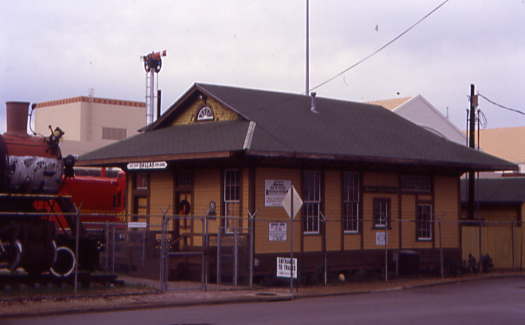
Houston & Texas Central Railroad Dallas depot built in 1905. The Houston & Texas Central was the first railroad to reach Dallas in 1872. The Texas & New Orleans arrived in 1903, by which time both railroads were part of the Southern Pacific system. The depot served passengers until 1918, when it became the Yardmaster's office. In 1963, it was relocated one-and-a-quarter miles from its original site to Fair Park with inauguration of the Age of Steam Railroad Museum, precursor to the Museum of the American Railroad.
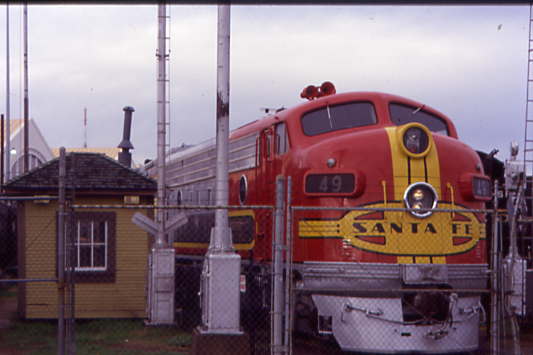
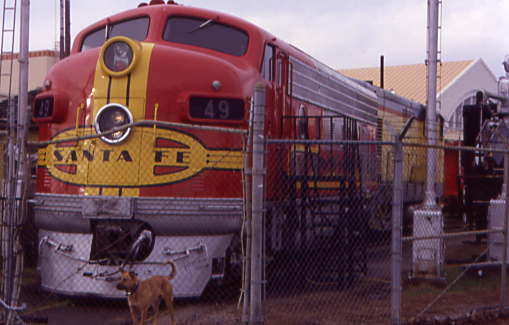
Beside it was Santa Fe F7A 49, nee Canadian National 9167 built by General Motors Diesel of Montreal, an Electro-Motive Division subsidiary, in 1952. Retired in 1989, itt was purchased by the museum in 2000 and repainted in the Santa Fe "Warbonnet".
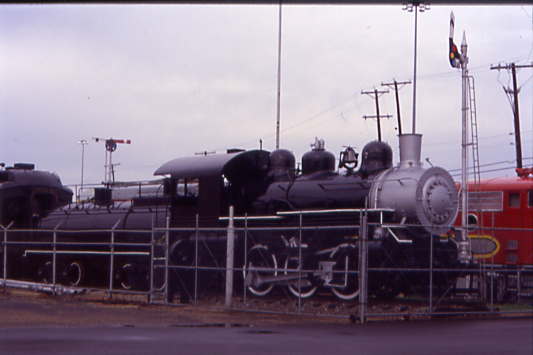
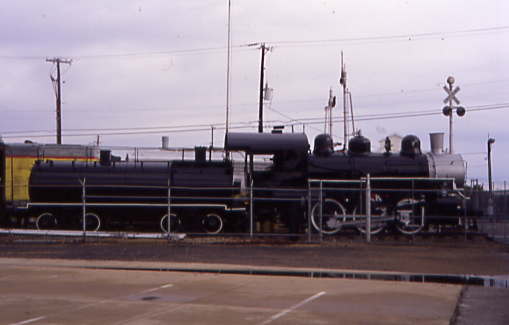
Dallas Union Terminal Company 0-6-0 7 built by Baldwin in 1923. Known as "Seven Spot", it worked its entire forty-year life on the DUTC handling passenger carriages, mail cars and express coaches at the Union Station in downtown Dallas. Retired in 1963, it steamed onto the museum property before its fire was dropped for the final time and it began restoration.
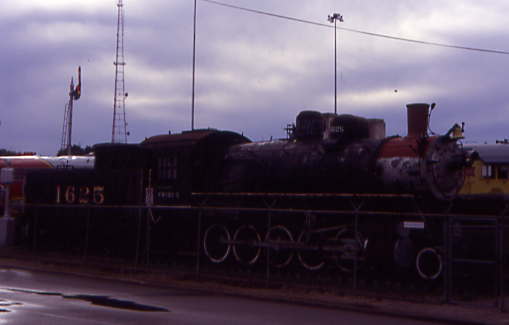
St. Louis-San Francisco 2-10-0 1625 1920, nee Eagle-Pincher Mining Company 1625, built by American Locomotive Company in 1918. It is one of about twelve hundred Decapod locomotives built for the Imperial Russian State Railway by American builders between 1917 and 1918. Over two hundred were never delivered because of the Russian Revolution, and were transferred to the United States Railroad Administration.
Over the years, they were fitted with stokers and a single thermic syphon. Built for Russia's five foot gauge, the locomotives were not regauged for the American standard gauge. Although the front pilot was replaced, the drivers were simply fitted with wider tires. Unfortunately, that meant the drivers could climb over the rail on tight curves but Frisco considered them good locomotives for work on secondary lines, and they remained in service into the 1950's. They were designed for freight but also hauled passenger services on occasion.
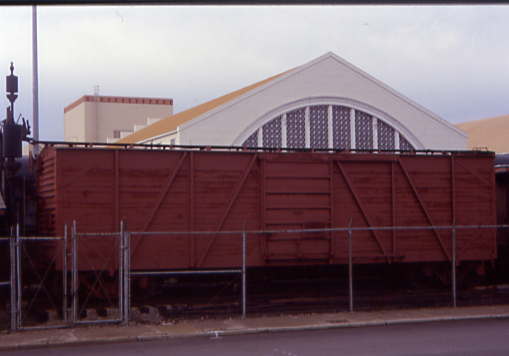
Kansas City Southern Lines outside-braced box car 7460, builder unknown but constructed in 1924 and donated in 1967.
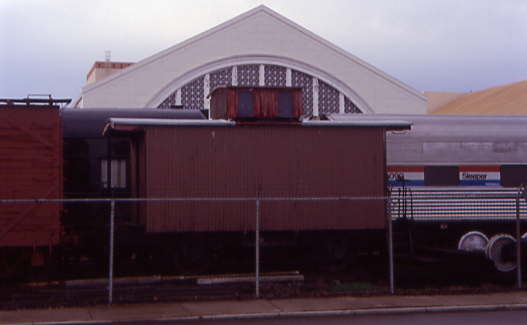
Texas & Northern Railway (Lone Star Steel Company, Lone Star, Texas) bobber caboose, ex. Malakoff Fuel & Iron Company, exx. Port Bolivar and Iron Ore Railroad, nee Buffalo Rochester and Pittsburgh Railway built by the railroad in 1895. It was donated to the museum in 1964.

Continuing around the site, Santa Fe 14-seat lunch counter/20-seat diner/kitchen car 1550 built by Budd Company in 1948, retired in 1969 and purchased in 2005.
Beginning in the early 1930's, the railroads began a program of modernizing passenger trains using railroad cars of lighter, streamlined passenger trains constructed of aluminum or stainless steel. The Chicago, Burlington & Quincy's "Pioneer Zephyr" began operation in 1934 and caused a sensation with its record breaking inaugural run. The entire three-car stainless steel trainset weighed 197,000 pounds - less than a single "heavyweight" Pullman car. The streamlined train came to represent the newest and finest in rail travel as the railroads sought to compete with airlines and the interstate highway system, and largely replaced the once common heavyweight Pullmans. Indeed, sleeping cars built by the Edward G. Budd company and owned by the railroads were a direct challenge to the traditional Pullman built, owned and operated sleeping car.
Santa Fe's all-coach, extra fare streamlined El Capitan increased in frequency from bi-weekly to daily service between Chicago and Los Angeles in 1948. The large number of patrons on the El Capitan required two lunch counter dining cars to be used on each train. Fourteen could be seated at the lunch counter and another 20 at tables, and the menu included a la carte and table d'hote meals by Fred Harvey. Lunch counter diners could be also be found in service on the Texas Chief and Grand Canyon, especially after the El Capitan was equipped with new hi-level equipment including 80 seat dining cars in 1956. Lunch counter car 1550 was retired by the Santa Fe and was used as a restaurant, but still retains its original Southwestern inspired décor from its days on the Santa Fe.
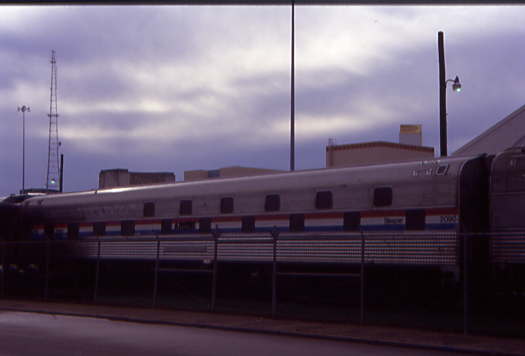
Amtrak 24 single room-8 double room slumbercoach 2090 "Loch Tarbet", ex. Burlington Northern 2028, exx. Northern Pacific 329 "Loch Tarbet", nee Missouri Pacific 699 "Southland" 699 built by Budd Company in 1959.
The Slumbercoach design was built to provide economical sleeping quarters at the lowest cost to the traveller and was one of the last new sleeping cars built by Budd. These cars provided private sleeping accommodations and a lavatory at a cost only slightly higher than coach travel but did not include the first class status provided other sleeping car patrons. "Southland" was in daily service between Washington, D.C. and San Antonio, in conjunction with three similar cars leased from Budd by the Baltimore and Ohio. They operated on the B&O's National Limited east of St. Louis and the Texas Eagle west of St. Louis. "Southland" was the only Slumbercoach operated by Missouri Pacific. Upon expiration of its lease in 1964, it was sold to the Northern Pacific and served on the North Coast Limited and Mainstreeter until its sale to Amtrak in 1971. Very popular with budget-minded travellers to the end, Amtrak did not retire its Slumbercoaches from service on its Silver Star and Silver Meteor trains until the late 1990's. The last of Amtrak's Slumbercoaches were sold at auction in 2001 and the Museum's Slumbercoach was purchased in 2005.
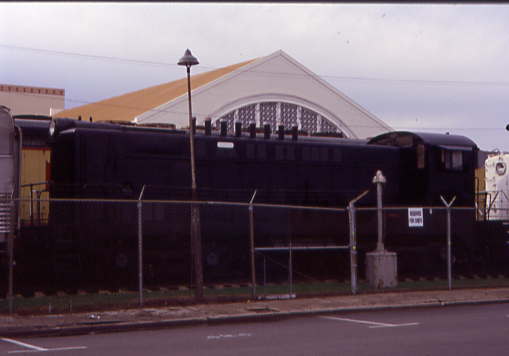
Western Railroad Company VO-1000 1107, nee Colorado Fuel & Iron Works 1107 built by Baldwin Locomotive Works in 1943. When owned by Western Railroad Company, it operated at its New Braunfels rock quarry then was donated to the museum in 1990 by the Parker-Lafarge Corporation.
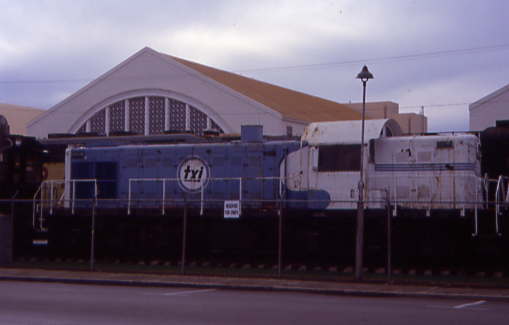
TXI Industries RSD1 8000, nee New York, Susquehanna and Western 8000, built by American Locomotive Company in 1942. Part of the first batch of thirteen RS-1s destined for five American railroads by Alco, all thirteen were subsequently requisitioned by the United States Army, returned to Alco and rebuilt as six axle RSD-1 units (USA #8000-#8012) for use on the Trans Iranian Railroad to supply the USSR during World War II.
During its War service, 8000 hauled materials to Stalingrad. It then returned to the United States and was sold as military surplus to TXI Industries. For twenty-five years it worked at the company's Midlothian concrete plant and was donated to the museum by TXI in 2000.
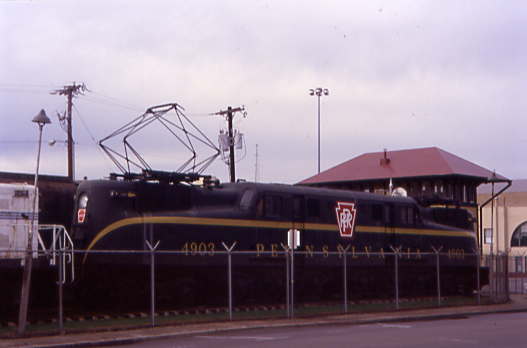
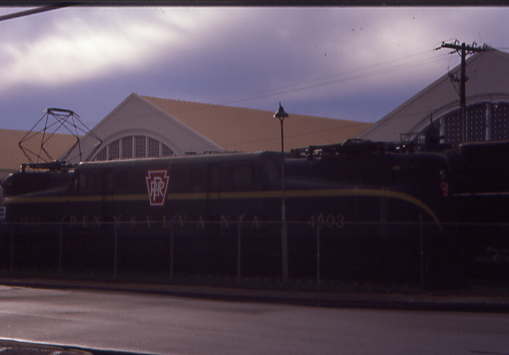
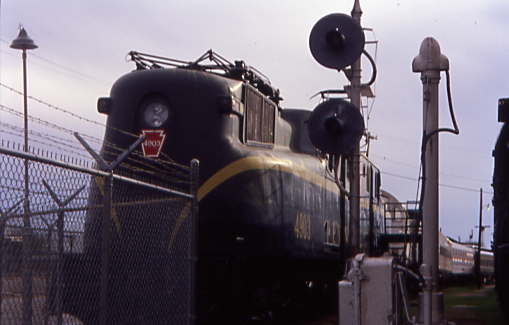
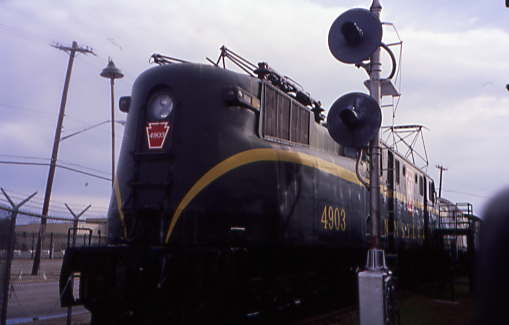
Amtrak GG-1 4096, ex. Penn Central GG-1 4903, nee Pennsylvania Railroad GG-1 4903 built by General Electric in 1940, designed to haul 12-14 car passenger trains on the Pennsylvania Railroad's electrified Northeast Corridor between Harrisburg and Philadelphia, New York City and Washington, DC.
As Penn Central 4903, along with Pen Central 4901, it pulled Senator Robert F. Kennedy's funeral train from New York to Washington, DC, on 8th June 1968. It was traded from the National New York Central Museum in Elkhart, Indiana in 1980.
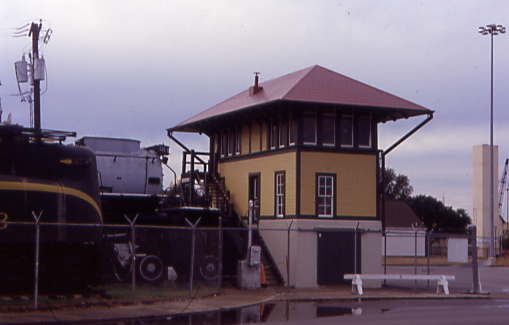
Gulf, Colorado & Santa Fe Interlocking Tower 19 is also on museum property. It was built to a modified Santa Fe standard plan in 1903 and equipped with General Railway Signal 103-function electric interlocker machine in 1952. The tower was originally located at the intersection of GC&SF and Missouri-Kansas-Texas Railways in South Dallas until being retired 1993 and donated in 1996.
Between 1903 and 1993, operators in the prairie-style balloon construction wooden structure controlled the movement of every train south and east of Dallas Union Terminal, and north and south over Santa Fe's Paris Branch from Cleburne through the line’s East Dallas classification yard. Tower 19 saw a number of changes and improvements during its life. Significant among them was a dramatic increase in east-west rail traffic through the Missouri-Kansas-Texas (now Union Pacific) side of the interlocking when the Texas & Pacific's main line through downtown Dallas was truncated in favor of the new "Belt Line" in 1924.
The tower’s original armstrong mechanical interlocker machine was replaced in 1952 in favor of General Railway & Signal's all-electric "pistol grip" machine. A centralized traffic control machine was added during the same period, controlling the movement of trains as far away as Arlington. The Tower 19 interlocking remained relatively untouched by surrounding growth in Dallas until the advent of Dallas Area Rapid Transit. The Tower, as well as the entire Santa Fe portion of the Paris Branch through East Dallas and Oak Cliff, became part of DART's Red Line to Westmoreland.
In 1992, Tower 19 was moved from the west side to the east side of the Santa Fe line to make way for light rail construction where it continued to function for another year. In 1993, the tower was officially retired and boarded up, with interlocking functions transferred to Union Pacific's remote facility in Omaha. In August, 1996 DART generously conveyed ownership of Tower 19 to the Museum, and it was moved to Fair Park. The Tower’s original location, sometimes referred to by historians and preservationists as the "Railroad District", remains a busy east-west artery for Union Pacific, Dallas, Garland & Northeastern, Amtrak and other railroads.
In 2004 the tower was meticulously restored by the Museum, including the application of a reproduction embossed metal tile roof, and a complete stripping and repainting of all exterior wooden surfaces. The upper floor of the tower still boasts its 112-function GRS electric interlocker machine – a marvel of electromechanical devices, along with the original overhead indicator boards. An architectural survey of Tower 19 was prepared in 1992 as part of the Historic American Engineering Record at the Library of Congress.
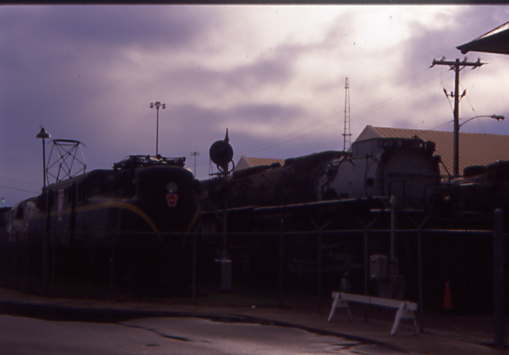
Union Pacific Big Boy 4-8-8-4 4018 and Pennsylvania Railroad GG-1 4903.
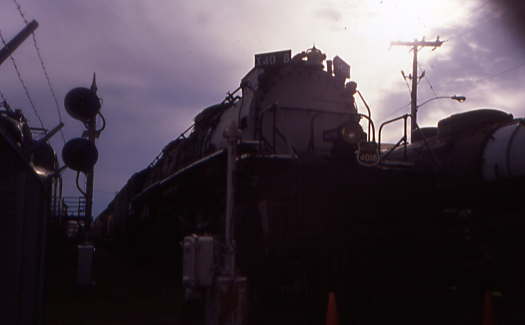
Union Pacific Big Boy 4-8-8-4 4018 built by American Locomotive Company in 1941. Built to haul high tonnage-freight, Big Boys mainly operated between Cheyenne and Laramie, Wyoming. 4018 last operated in October 1957 before gooing into storage with several other steam locomotives at Union Pacific's Cheyenne shops but was not officially retired until 1962. It was donated to the museum by Union Pacific in 1964 and arrived on site in 1965, having travelled from Wyoming to Kansas City and then south via AT&SF trackage to Dallas.
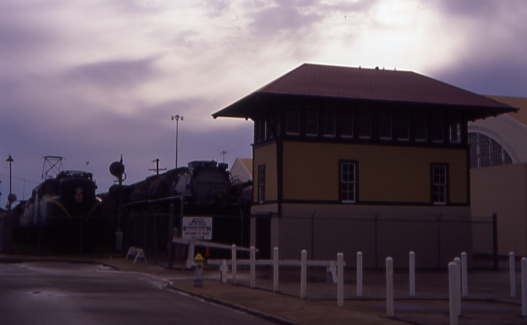
Tower 19, Union Pacific 4018 and Pennsylvania Railroad 4903.
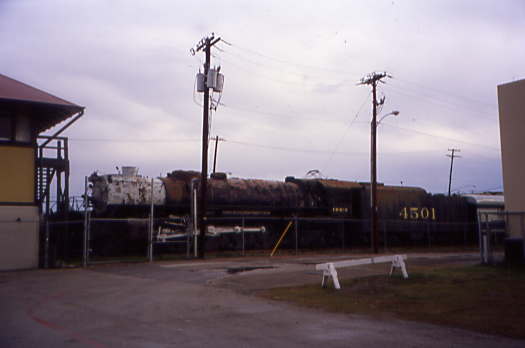

St. Louis-San Francisco Railway 4-8-4 4501 built by Baldwin Locomotive Works in 1942 and is one of three Northerns designed to haul the St. Louis-San Francisco's crack overnight Meteor passenger service from Oklahoma City via Tulsa to St. Louis. They were delivered in zephyr blue, white and grey, with "Meteor" across the tender in distinctive red lettering. The three locomotives also hauled the Texas Special but, when it and the Meteor were dieselised in 1947, they were re-painted in SLSF's standard black with gold striping and lettering and assigned to other passenger trains such as the General Wood and Will Rogers; and were the last steam locomotives purchased by SLSF.
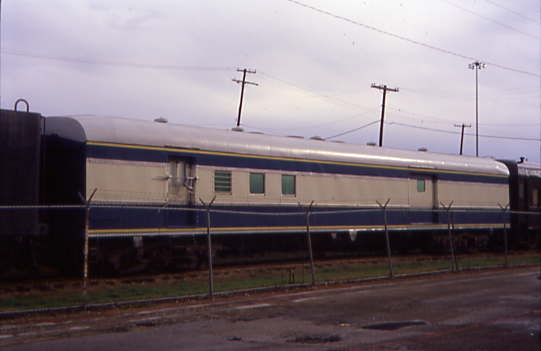
Texas & Pacific Railway railway post office-baggage car 916 1941, ex. Texas and Pacific coach-mail 816 1925, nee Texas and Pacific coach-baggage 64 built by Pullman Car Works in 1916 It was modernized in 1954 and would have been re-numbered 1038 but the car was condemned in 1963 upon discovery of a cracked frame and subsequently retired. It was donated to the museum in 1964.
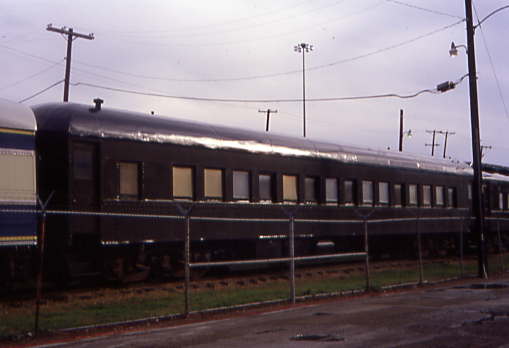
St. Louis-San Francisco Railway 56-seat chair car 759 built by American Car and Foundry in 1912. This is one of the few remaining Jim Crow cars still in existence and were used during segregation in the South. It was donated in 1966.
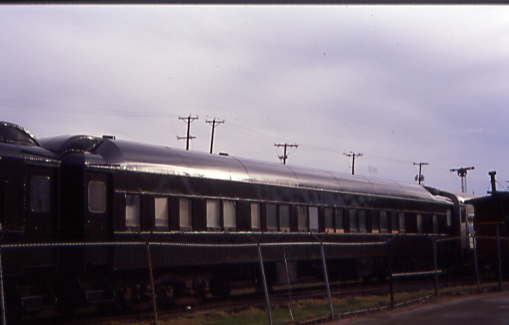
Pullman 7 compartment-2 drawing room sleeping car "Glengyle" built by Pullman Company in 1918. The car was used in Florida-New York service on the Atlantic Coast Line but ended its career on the Southern Railway. It provided first class accommodations for family and dignitaries on Franklin Roosevelt's funeral train in 1945 then was in use as a dormitory by the Texas & Northern before donation to the State Fair of Texas Age of Steam exhibit in 1964.
Today the Glengyle is the only existing car of 10,000 cars of its configuration and is the earliest known survivor of the fleet of heavyweight, all-steel sleepers built by the Pullman Company. "Glengyle" represents a shift in technology from cars of wooden construction to steel, a change which brought improved safety to rail travel. It has been designated an engineering landmark by the American Society of Mechanical Engineers.
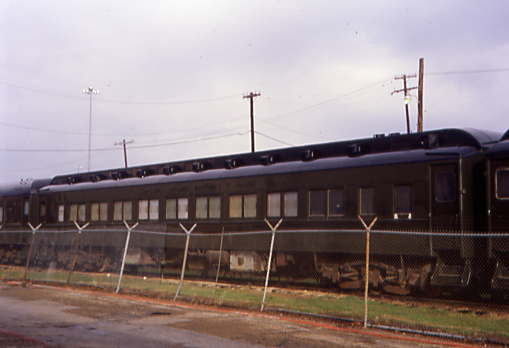
Pullman 12 open section-1 drawing room sleeping car "Goliad" built by Pullman Car and Manufacturing in 1926. It was one of 24 such sleeping cars put into service on Southern Pacific's New Orleans to San Francisco "Sunset Limited" in 1926. Many of the cars in this series were named for cities, counties and rivers along the Southern Pacific's route, such as Alamo, Aransas, Bexar, Brazos, Iberia, Pecos, Presidio and Trinity. "Goliad" was doubly significant as the site of the Battle of Coleto Creek and subsequent massacre of Colonel James Fannin and his men during the Texas Revolution.
Because of the warm climates in which it operated, the car was equipped with mechanical air conditioning in 1935. After the Pullman divestiture, Southern Pacific purchased the car though it was still operated and maintained by Pullman. The Sunset Limited received new streamlined, stainless steel cars in 1950, leaving the older equipment available for other service. "Goliad" last served with the Fort Worth & Denver Railway in December 1963 and was donated by the Southern Pacific Company in January 1964.
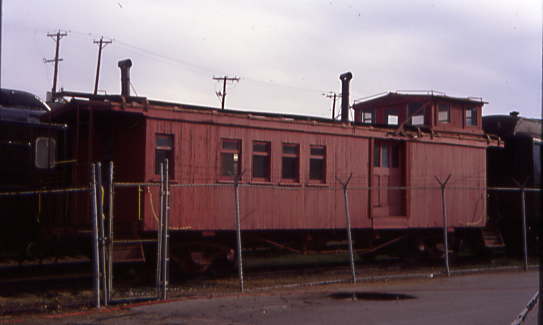
St. Louis-Southwestern Railway wooden caboose 2332 built by the railroad in 1920 and donated in 1966.
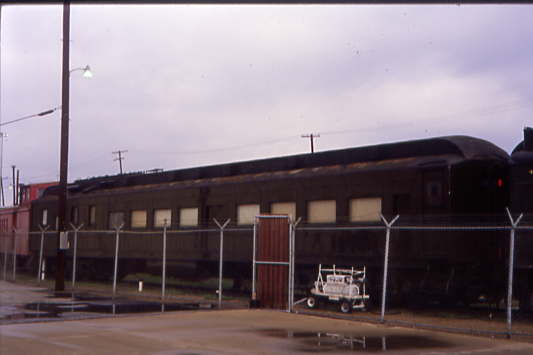
Santa Fe Railway lounge car with 14 parlour seats, club section, dormitory space 3231 1935, nee Santa Fe parlour-observation car 3218 built by Pullman Car Works in 1914. It was retired in 1964 and donated in 1966.

Missouri-Kansas-Texas Railroad 36-seat dining car 3, ex. Missouri-Kansas-Texas "Fort Worth", nee Missouri-Kansas-Texas 438 "Goliad" built by American Car and Foundry in 1937 and purchased by the museum in 1964.
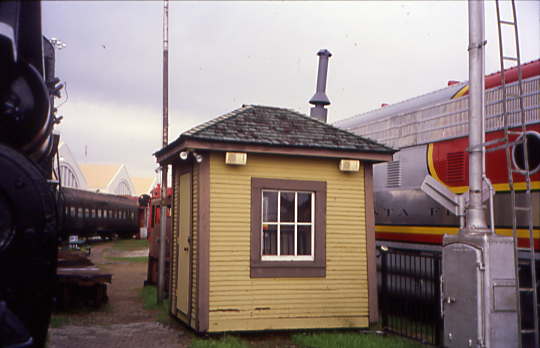
A small section house.
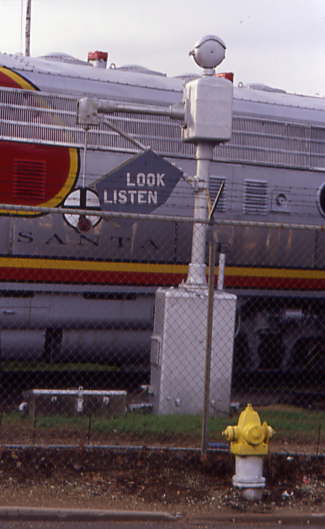
An upper-quadrant wig-wag crossing system.

As I had walked all the way around the Museum, I returned to the car to escape the cold and wind. Just before 10:00 AM, two museum employees arrived and went inside and about ten minutes later, I called to explain I was here to write a story and they opened the museum. We checked in and after browsing the indoor exhibits, Chris Parker and I continued looking around outside. Mr. Jeff Phelps then came out to guide us around the museum and answer any questions. One passes through the station building to gain access to the exhibits inside the museum's grounds.
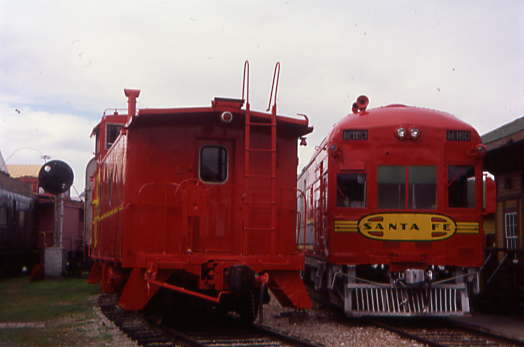

Santa Fe diesel-electric motorcar 160 built by Brill Motorcar Company in 1931 as a 535 hp gas-electric combined baggage/motor car which was generally coupled to one or two passenger coaches when in service. Originally painted with a zebra-striped front,M-160 was eventually repainted in the renowned red, yellow and silver Santa Fe "Warbonnet" scheme. It underwent major rebuilds in 1948 and 1952, when it was fitted with a diesel engine and components from AT&SF's first E-1 passenger locomotive.
M-160 spent much of its service life on AT&SF's rural branch lines, initially between Amarillo and Carlsbad, New Mexico. It later ran on the Wichita, Kansas to San Angelo, Texas route and its last service run was between Carlsbad and Clovis on trains 25 and 26, The Cavern. M-160 was retired in 1966 and went into storage at Clovis until it was donated to the museum in 1969.
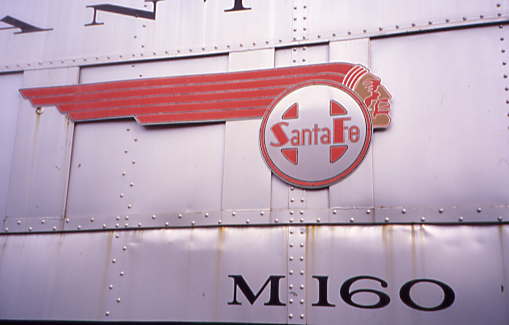
The Santa Fe emblem on the side.
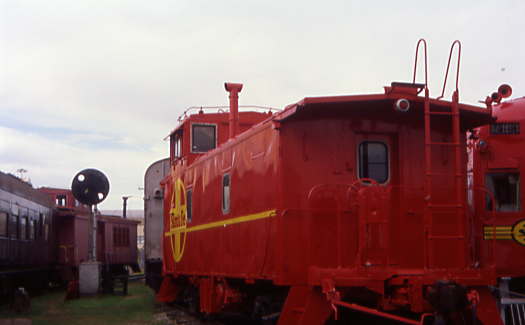
Santa Fe Railway caboose 999311 1968, nee Santa Fe 512, built by the railroad in 1949. It was donated in 2001.
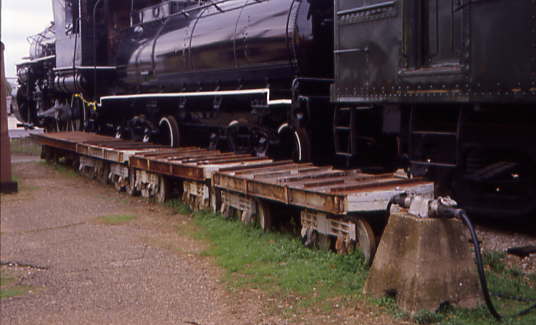
Narrow gauge flat cars beside Dallas Union Terminal Company 7.
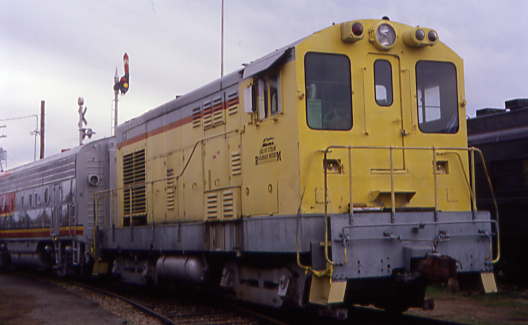
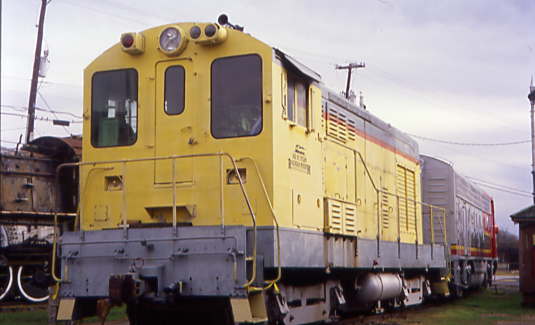
Southwest Portland Cement Company H12-44 115 1975, ex. Southern Pacific 2379, nee Southern Pacific 1581 1956 built by Fairbanks Morse in 1956. Most of these switchers operated in the San Francisco area until being retired and this one was bought by the museum in 1993 and is now their main switcher.
We then toured Missouri-Kansas-Texas dining car 438 and Santa Fe parlour car 3231.
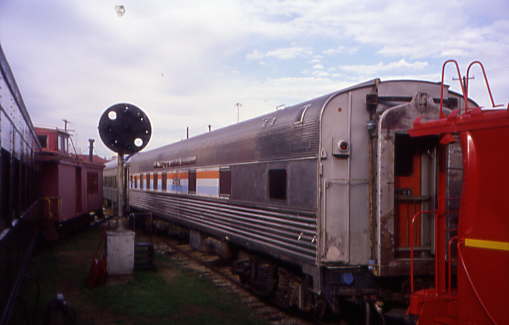
Amtrak 10 roomette-6 double bedroom sleeping car 2297 "Pine Ring", nee Santa Fe 1642 "Pine Ring" built by Budd Company in 1950. One of 27 "Pine series" cars built that year for the 1951 edition of Santa Fe's all first class Chicago to Los Angeles "Super Chief", it also operated on the Texas Chief, as well as in run-through service from Washington, D.C. to Chicago on the Baltimore and Ohio Capitol Limited. The car continued in service from creation of Amtrak in 1971 and served as part of Amtrak's "heritage fleet" until retirement. Several of the "Pine series" cars remain in use on Amtrak as crew dormitories even after more than 55 years of service. "Pine Ring" was graciously donated by Ms. Katherine Schultz in 2005.
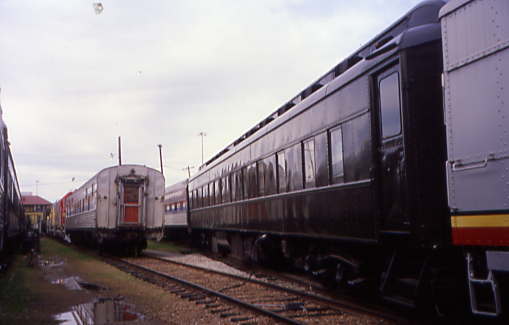
HWCR research car 1, nee Pullman 6 compartment-3 drawing room sleeping car "Glen Nevis" built by Pullman Car and Manufacturing in 1925, one of Pullman's most common all-room car and one of its most luxurious designs. It was purchased by Freight Masters Industries of Fort Worth and converted to a rolling laboratory for designing coupler cushioning devices. While it still has the external appearance of a Pullman sleeping car with a few of the drawing rooms retained, "Glen Nevis" was modernized with its own kitchen and generator so it could be self-sufficient while on the railroad. It was donated by the Freight Master division of Halliburton in 1997.
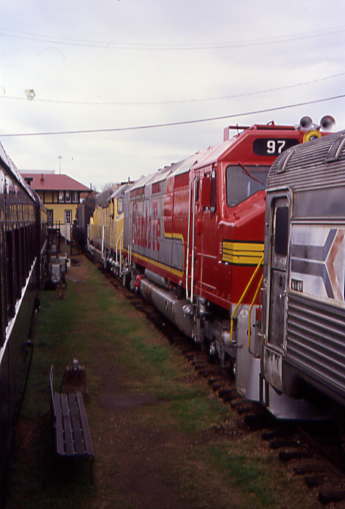
BNSF FP45 97, ex. Santa Fe 5997, exx. Santa Fe 105, exxx. Santa Fe 5997, nee Santa Fe FP45 107 built by Electro-Motive Division in 1967. Designed specifically for Santa Fe, which did not want its prestigious Super Chief, El Capitan and other "varnish" passenger trains pulled by freight-style hood-unit locomotives with external walkways. The AT&SF preferred a cowl unit and this cab design has been used on many subsequent locomotives.
When Amtrak took over passenger services in 1971, the AT&SF FP45s were reassigned to fast freight service, repainted in the standard blue and yellow freight scheme and renumbered. Eventually, the units were repainted in a modified AT&SF "Warbonnet" and renumbered. 97 was the last in service and was donated to the museum by BNSF in 1999.
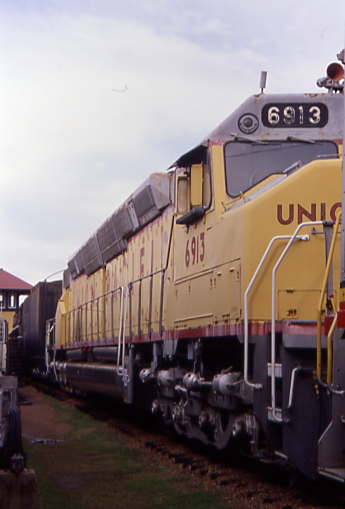
Union Pacific DD40AX 6913 built by Electro-Motive Division in 1969, one of forty-seven built between 1969 and 1971 and the largest and most powerful single diesel units. They were named "Centennials" in honour of the driving of the Golden Spike at Promontory, Utah, one hundred years previously in 1869. The DDA40Xs hauled fast freight over most of the Union Pacific system until high maintenance costs forced their eventual retirement in the mid-1980's.
6913 was built at a cost of $551,168 and delivered to the Union Pacific in 1969. It was retired in 1986, by which time it had run up 2 million miles of service. It was donated to the museum in 1986 by the Union Pacific.
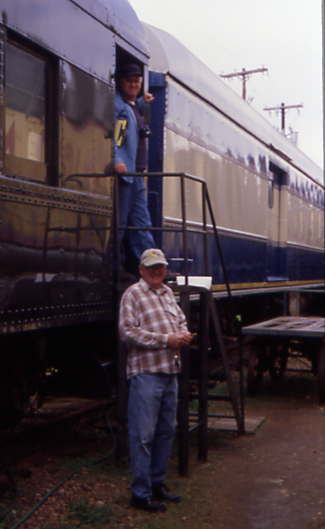
Chris Parker and Jeff Phelps. We were able to visit the cabs of both UP Big Boy 4018 and Frisco 4501.
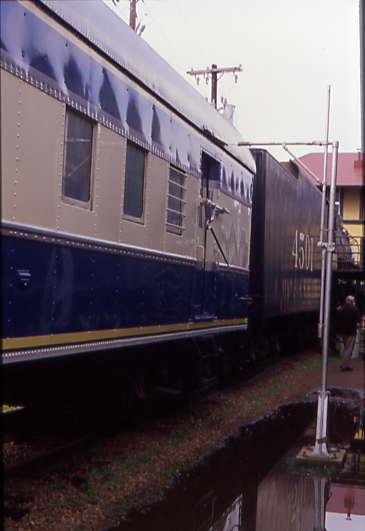
A mail stand outside Texas & Pacific RPO car 916.
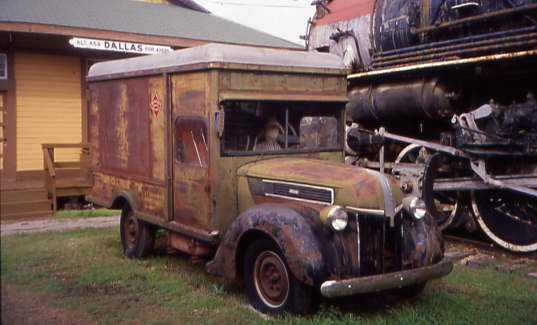
Railway Express Agency one ton box truck built by Ford in 1941, was the final exhibit. We thanked Jeff and the women inside for the fantastic visit to the Museum of the American Railroad.
When we exited the freeway on our way to the museum, we had spotted some former Santa Fe hi-level coaches which Amtrak turned into coach-dorms. After our visit, we drove around plenty of construction but finally were able to get close enough for pictures.
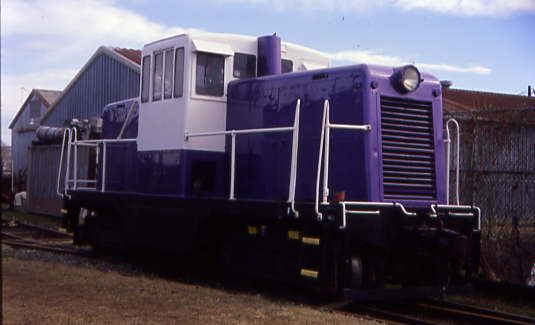
A centre-cab switcher of unknown origin.
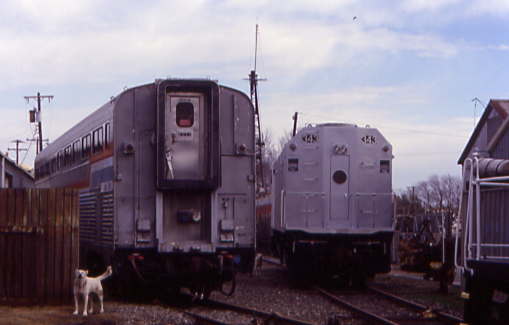
Amtrak F40PH 343 built by Electro-Motive Division in 1980.
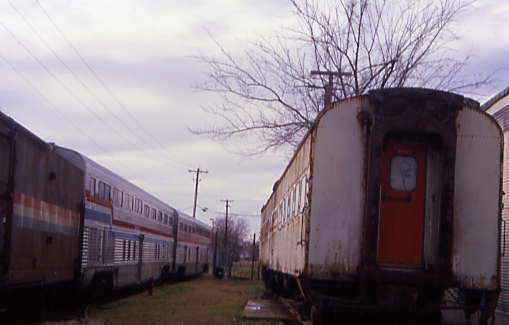
Former Santa Fe hi-level cars 39901 and 39934.
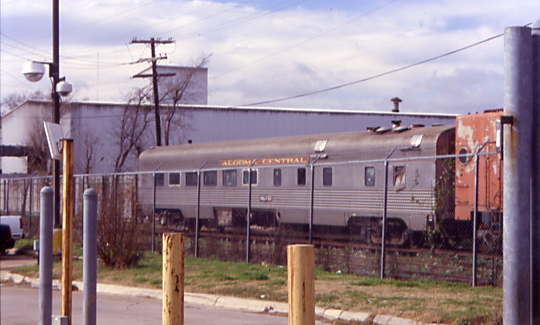
Algoma Central dining car 504, ex. Cadillac & Lake City Railway "Emerald Lake", nee Santa Fe 1554) built by the Budd Company in 1948 and donated to the museum in 1995.
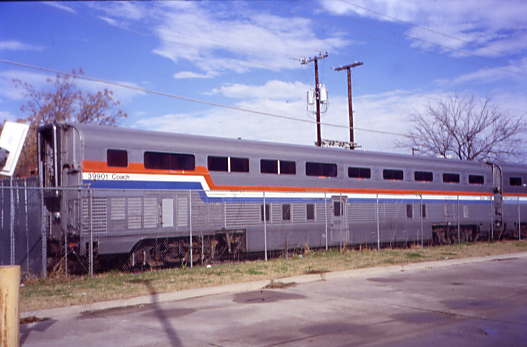
Amtrak hi-level coach 39901, ex. Amtrak 9943 nee Santa Fe 703 built by Budd Company in 1956.
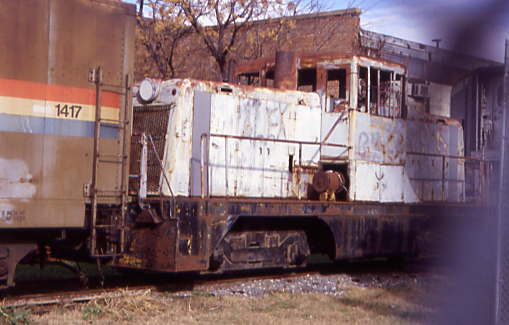
Pennsylvania Railroad 44 ton switcher 9356 built by General Electric in 1948, the last such switcher built for the railroad. It worked for both Penn Central and Conrail then later, Dallas Terminal Railway.
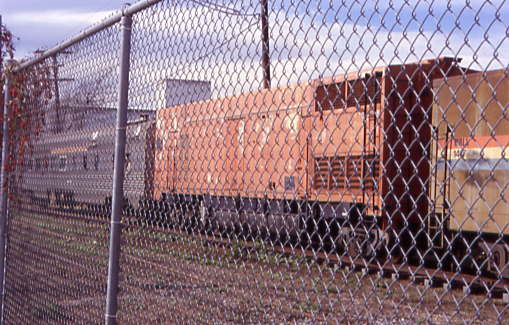
Southern Pacific maintenance-of-way F7B 8209, nee Southern Pacific 6151C built by Electro-Motive Division in 1949. It was retired in 1972 during conversion to a snow removal power unit by the Sacramento Shops and donated by the California State Railroad Museum.

Amtrak hi-level coach 39934, ex. Amtrak 9934, nee Santa Fe 734 built by Budd Company in 1964.
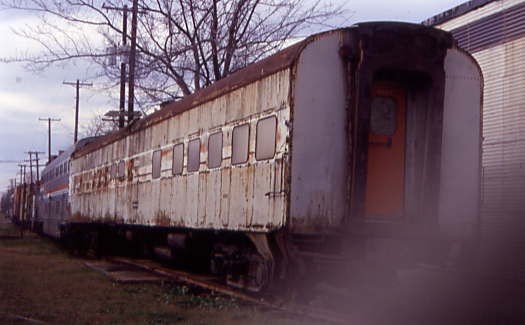
Santa Fe lunch counter-diner 1554 built by Budd Company in 1948.
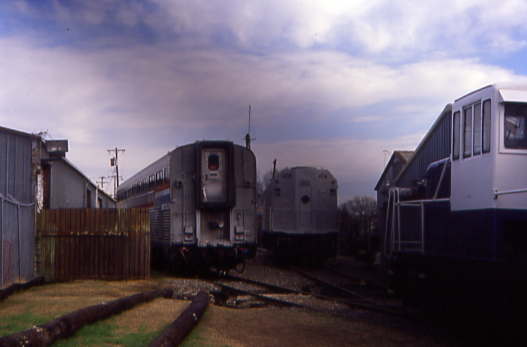
Amtrak F40PH 343 and Amtrak 39918. We returned to the rental car and resumed our journey on Interstate 30 West, taking that to Interstate 35 East.
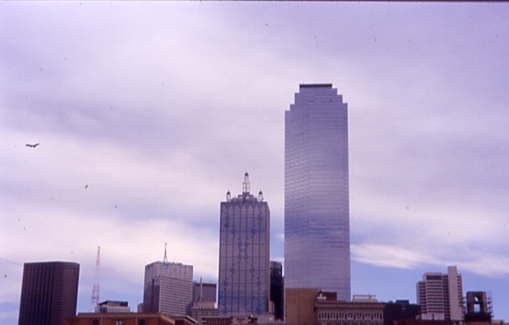
The skyline of downtown Dallas before exiting onto Texas 114 west to Grapevine, where we followed the signs to our next rail adventure, the Grapevine Vintage Train.
| RETURN TO THE MAIN PAGE |